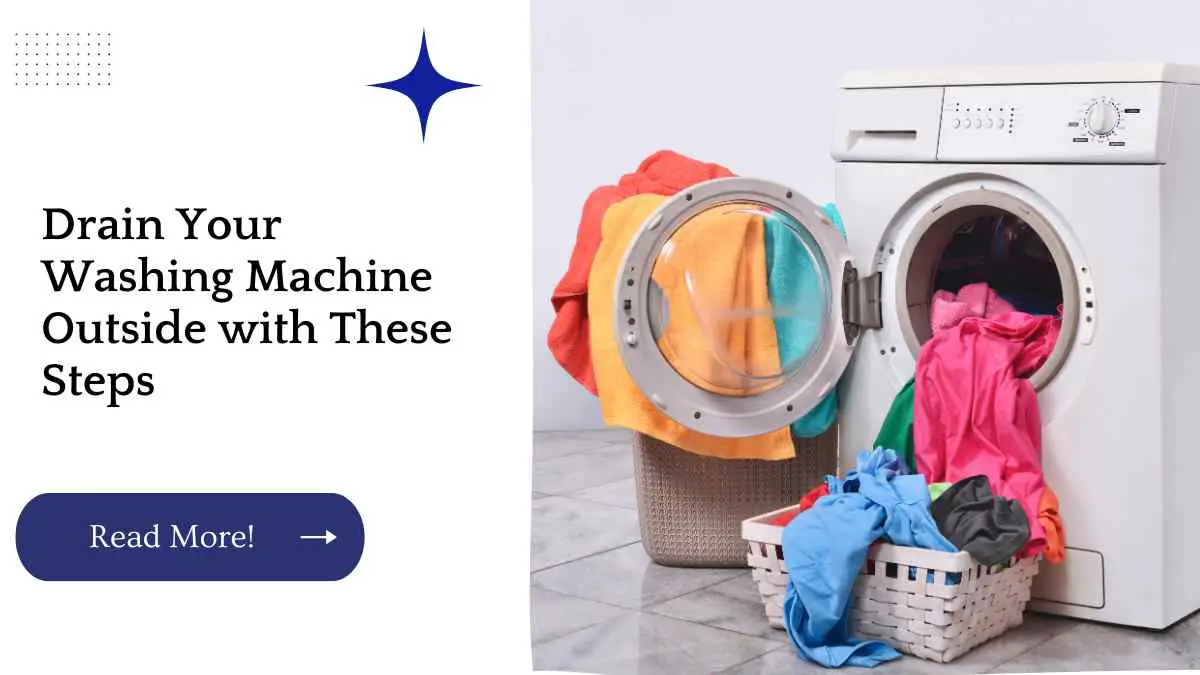Washing machines are a staple in most households. While they make laundry day easier, they can also cause issues such as leaks and clogs. One way to avoid these problems is to drain your washing machine outside.
This article will guide you through the process of draining your washing machine outside and provide helpful tips and tricks to make the process as smooth as possible.
| Key Takeaways |
|---|
| Draining your washing machine outside can prevent leaks and clogs inside your home. |
| Make sure to turn off the power and water supply before draining your washing machine outside. |
| You will need a hose, pliers, a bucket, and a wrench to drain your washing machine outside. |
| Follow the step-by-step guide carefully to ensure the process goes smoothly. |
| Clean your washing machine drain line regularly to prevent future issues. |
Reasons to Drain Your Washing Machine Outside
There are several reasons why you may want to drain your washing machine outside. Firstly, it can prevent leaks and clogs inside your home. Secondly, it can be a more convenient option, especially if you have a large family or do laundry frequently. Additionally, it can save you money on plumbing repairs in the long run.
Precautions Before Draining Your Washing Machine Outside
Before you begin draining your washing machine outside, it’s important to take a few precautions to ensure your safety and prevent any damage. Firstly, turn off the power and water supply to your washing machine. Secondly, make sure to wear gloves and eye protection to avoid any injuries. Finally, make sure to place a bucket under the drain hose to catch any excess water.
If you’re struggling with plumbing issues when it comes to washing machines, our DIY tips for basement washing machine drain plumbing can help you troubleshoot common problems easily and affordably
Tools and Materials You Will Need
To drain your washing machine outside, you will need the following tools and materials:
- A garden hose
- Pliers
- A bucket
- A wrench
Step-by-Step Guide to Draining Your Washing Machine Outside
Follow these steps to drain your washing machine outside:
- Locate the drain hose at the back of your washing machine.
- Remove the drain hose from the wall or standpipe.
- Connect the garden hose to the end of the drain hose.
- Place the other end of the garden hose outside, preferably in a location where the water can drain freely.
- Turn on the washing machine and allow it to drain completely.
- Once the washing machine has drained, turn off the power and water supply.
- Disconnect the garden hose from the drain hose.
- Reattach the drain hose to the wall or standpipe.
- Dispose of any remaining water in the bucket.
An efficient laundry setup is essential for maintaining maximum productivity and functionality in your home. With proper washing machine and sink drainage, you can enjoy hassle-free laundry days and keep your home clean and organized.
Tips and Tricks for Draining Your Washing Machine Outside
Here are some helpful tips and tricks to make the process of draining your washing machine outside even easier:
- Use a hose with a large diameter to allow water to drain more quickly.
- Place a brick or other heavy object on theend of the garden hose outside to keep it in place and prevent it from moving.
- Make sure the garden hose is not kinked or bent, as this can impede the flow of water.
- If the water is not draining quickly enough, try lifting the end of the garden hose higher to create more of a slope and allow the water to flow more freely.
Common Mistakes to Avoid When Draining Your Washing Machine Outside
While draining your washing machine outside is a simple process, there are a few common mistakes you should avoid to prevent any issues:
- Forgetting to turn off the power and water supply before draining the machine can cause electrical shocks or water damage.
- Allowing the garden hose to become kinked or bent can impede the flow of water and cause leaks.
- Failing to properly secure the garden hose outside can cause it to move or come loose, resulting in water damage.
Is your washing machine draining into your sink causing a plumbing nightmare? Our step-by-step guide on fixing the issue can help walk you through troubleshooting and repair techniques to get your machine back in working order.
How to Clean Your Washing Machine Drain Line
Cleaning your washing machine drain line regularly can prevent clogs and other issues from occurring. Here’s how to do it:
- Locate the drain line at the back of your washing machine.
- Remove the drain line and clean it thoroughly with hot water and a cleaning solution.
- Use a wire brush or other tool to remove any stubborn debris or buildup.
- Reattach the drain line and run a cycle of hot water and vinegar through the washing machine to flush out any remaining debris.
Conclusion
Draining your washing machine outside is a simple and effective way to prevent leaks and clogs inside your home. By following the steps and tips outlined in this guide, you can easily and safely drain your washing machine outside.
Remember to take the necessary precautions and avoid common mistakes to ensure a smooth and hassle-free process. Additionally, make sure to clean your washing machine drain line regularly to prevent future issues.
Further Reading
Here are some additional resources to help you learn more about draining your washing machine outside:
How to Drain a Washing Machine by Hand: This article from Wikihow provides a step-by-step guide to draining your washing machine by hand, which can be helpful if you don’t have access to a garden hose.
How to Drain a Washing Machine: This article from Bob Vila provides a comprehensive guide to draining your washing machine, including both inside and outside methods.
How to Run a Washing Machine Drain Outside: This article from Dave Burroughs provides a detailed guide to running your washing machine drain outside, including tips for preventing leaks and clogs.
If you’re looking to drain your washing machine outside, our helpful steps for doing so can guide you through the process to ensure safe and efficient drainage.
FAQs
Here are some frequently asked questions about draining a washing machine outside:
1. Can I drain my washing machine outside without a hose?
No, you will need a garden hose to drain your washing machine outside. Without a hose, the water will not have a clear path to flow and can cause damage to your property.
2. Can I drain my washing machine outside in the winter?
Yes, you can drain your washing machine outside in the winter, but you will need to take additional precautions to prevent the water from freezing. Consider using a heated hose or insulating the garden hose to prevent freezing.
3. How often should I clean my washing machine drain line?
It is recommended to clean your washing machine drain line at least once every three months to prevent clogs and other issues.
Say goodbye to constantly draining water heaters and hello to a consistent and reliable source of hot water by reading our article on solving common hot water issues. From troubleshooting to repair, our tips and advice will give your home the comfort you deserve.
4. What should I do if the water is not draining from my washing machine?
If the water is not draining from your washing machine, there may be a clog in the drain line. Try cleaning the drain line and using a plunger to remove any stubborn clogs. If the issue persists, contact a professional plumber.
5. Can I use the water from my washing machine to water plants?
Yes, you can use the water from your washing machine to water plants. However, make sure to avoid using any detergents or fabric softeners that may harm the plants.
In conclusion, draining your washing machine outside is a simple and effective way to prevent leaks and clogs inside your home. By following the steps outlined in this guide and taking the necessary precautions, you can easily and safely drain your washing machine outside.
Remember to clean your washing machine drain line regularly to prevent future issues and avoid common mistakes to ensure a smooth and hassle-free process.

Hellen James is the author of the blog and a licensed plumber with over 15 years of experience. She shares her knowledge and experience in plumbing and drainage through insightful and informative articles

